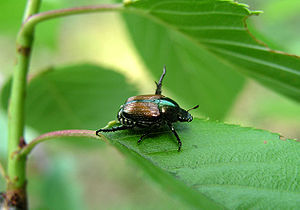Popillia japonica
| Japanese Beetle | |
|---|---|
 | |
| Type: | Insect |
| Binomial: | Popillia japonica |
| Family: | Scarabaeidae |
| Order: | Coleoptera |
| Metamorphosis: | Complete |
| Damaging stages: | Larval, adult |
| Generations per year: | one |
| Vulnerable stages: | Larval, adult |
The Japanese beetle is a scarab beetle which is present throughout much of North America as an invasive species. It can be a devastating pest of both crops and gardens, especially as they tend to occur in large numbers.
As the name suggests, the beetle is native to Japan, where it is a relatively minor pest due to the presence of natural predators. The insect was first found in the United States in 1916 in a nursery near Riverton, New Jersey. It is thought that beetle larvae entered the United States in a shipment of Iris bulbs prior to 1912 when inspections of agricultural commodities entering the country began.
Life cycle
editThe larvae live in the soil, where they feed on roots, particularly those of turfgrasses. Adults emerge in early summer, feeding on flowers and leaves. Eggs are laid in late summer, and larvae begin feeding, burrowing deep to overwinter.
Description
editThe Japanese beetle (Popillia japonica) is a beetle about 1.5 cm (0.6 inches) long and 1 cm (0.4 inches) wide, with shiny copper-colored elytra and a shiny green top of the thorax and head. It is not very destructive in Japan, where it is controlled by natural enemies, but in America it is a serious pest to rose bushes, grapes, crape myrtles, and other plants. It is a weak flyer and drops several centimeters when it hits a wall.
Japanese beetles have a curious, identifying defense; they lift their hind legs up in the air, even when simply approached. These hind legs are spiny, and the behavior is probably intended to ward off predators.
Symptoms and Signs
editAdults skeletonize leaves and flower petals, leaving only the veins behind. Heavy infestations can completely denude even large trees.
Larvae eat the roots of grasses, causing dead patches in lawns as the tops die off.
Ecology
editThe life cycle of the beetle is typically 1 year in most parts of the United States, but this can be extended in cooler climates; for instance, in its native Japan, the beetle's life cycle is 2 years long as a result of the higher latitudes of the grasslands required for the larval stage.
-
The Japanese beetle adult--an attractive pest
-
A typical cluster of Japanese beetle eggs
-
Japanese beetle larva
-
Japanese beetle pupa
Host plants
edit- Abelmoschus
- Acer
- Aesculus
- Alcea
- Asparagus
- Aster
- Betula (Birch trees)
- Buddleia
- Calluna
- Canna
- Capsicum (Pepper)
- Chaenomoles
- Cirsium
- Cosmos
- Dahlia
- Daucus
- Dendranthema
- Digitalis
- Dolichos
- Fragaria (Strawberry)
- Hemerocallis
- Heuchera
- Hibiscus
- Hydrangea
- Ilex
- Iris
- Lagerstroemia
- Ligustrum
- Malus
- Malva
- Myrica
- Oenothera
- Parthenocissus
- Phaeseolus
- Phlox
- Physocarpus
- Platanus
- Polygonum
- Prunus
- Pyrus
- Quercus
- Rheum
- Rhododendron
- Rosa
- Rubus
- Salix
- Sambucus
- Sassafras
- Solanum (Tomato, Eggplant, Potato, etc.)
- Syringa
- Tilia (Linden, lime, or basswood trees)
- Toxicodendron
- Ulmus
- Vaccinium
- Viburnum
- Vitis
- Weigelia
- Wisteria
- Zea
- Zinnia
Control
editDuring the larval stage, the Japanese beetle lives in lawns and other grasslands, where it eats the roots of grasses. During that stage, it is susceptible to a fatal disease called milky spore disease, caused by a bacterium called milky spore, Bacillus popilliae. The USDA developed this biological control and it is commercially available in powder form for application to lawn areas. Standard applications (low density across a broad area) take from 1 to 5 years to establish maximal protection against larval survival (depending on climate), expanding through the soil through repeated rounds of infection, in-host multiplication, release from killed host, and infection. Typically proper application can lead to a 15-20 year period of protection.[1]
Soil-bound larvae are also susceptible to certain members of the nematode families Steinernematidae and Heterorhabditidae. As with milky spore, commercial preparations of these nematode varieties are available.
The primary natural predator found in Japan is the w:winsome fly (Istocheta (or Hyperecteina) aldrichi), a parasitic fly. Attempts at establishing this predator in the United States have met with limited success, primarily in New England. Alternative predators have shown some potential at serving as biological controls, such as the w:Spring tiphia (Tiphia vernalis) and w:Fall tiphia (Tiphia popilliavora) from China and Korea. Also, certain birds (such as the meadowlark and cardinal) and small mammals are significant predators on the adult form.
On field crops such as eggplant, floating row covers can be used to exclude the beetles, however this may necessitate hand pollination of flowers. Kaolin sprays can also be used as barriers.
Research performed by many US extension service branches has shown that pheromone traps may attract more beetles than they catch, and so they have fallen out of favor.[2] Natural repellents include catnip, chives, garlic, and tansy[3], as well as the remains of dead beetles.
References
edit- ↑ Klein, Michael (August 1998). Japanese beetle: the continuing struggle to achieve successful biological control. Midwest Biological Control News, V(8). Retrieved July 11, 2005.
- ↑ Japanese Beetle control strategies [1]
- ↑ http://www.selfsufficientish.com/pests.htm